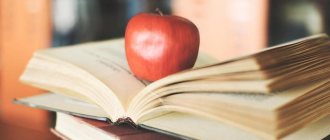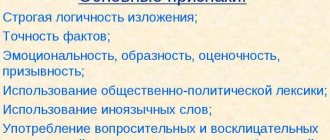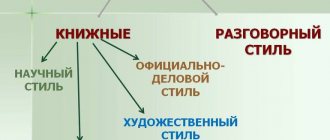Historical excursion
In Ancient Greece, the privileged class used special terminology that ordinary people did not understand. It was to this time that experts attribute the appearance of the first signs of the scientific style. All terms were called only in Latin, but over time, scientists began to translate details into other languages.
Narrow-profile areas of activity began to expand. Initially, the scientific style of speech differed little from the artistic one, but over time, characteristic features began to appear and the style became clear and concise.
As an example, we can recall Descartes’ negative review of Galileo’s works. The French philosopher and mathematician believed that the Italian physicist tended to use a large number of artistic devices in the text. Kepler also held a similar opinion. For a long time, the standard of style was the work of Isaac Newton. Everyone tried to imitate him in their works.
In the Russian state, a style for scientific work began to take shape only at the beginning of the 18th century. Mikhail Lomonosov especially helped in its development, who developed certain characteristics of the style.
The formation process was finally completed in the 19th century and was associated with the activities of major scientists. Today, the style of scientific works has a number of features that make it easy to distinguish it from other styles of the Russian language:
- Logicality - all parts of the text have a strict sequence and end with a conclusion. Sentences are linked by repeating nouns and demonstrative pronouns. Adverbs, conjunctions, and introductory words also indicate consistent presentation.
- Precision - all words are used only in the literal sense. Terminology is widely used. Key phrases may be repeated many times.
- Objectivity - describes the results of experiments and the patterns that were identified.
- Generalization - when writing a text, the author uses abstract concepts that are almost impossible to imagine, feel, or understand.
If necessary, the text is illustrated with graphs, diagrams, diagrams. You can apply formulas, calculations, and make tables. The author’s task is to fully disclose the topic.
History of origin
The scientific style arose relatively recently. And its formation is not finished yet. One might assume that this style arose simultaneously with science, that is, when philosophers and scientists of antiquity began to systematize experience in various fields. But that's not true.
Upon closer examination, it is easy to understand that the scientific works of the times of Plato and Aristotle were distinguished by an emotionality and subjectivity completely unusual for the scientific style.
This is explained by the fact that the accumulated experience was so small that it did not yet require the use of functional terminology for description. The appearance of a separate style is associated with the Alexandrian period, when a sufficient number of special terms had already been formed in the Greek language, which later came from Greek to other languages.
In the Middle Ages, European science was closely connected with religion and spoke the same language with it.
Latin is the language of medieval scientists and theologians. This largely determined the further development of special terminology in all areas of science.
In Europe, the final separation of the scientific style from the artistic style can be attributed to the Renaissance.
It was during this period that scientists, in the pursuit of accuracy and brevity in the abstract-logical description of phenomena, moved away from the use of emotional artistic means of language.
In Russia, this style originates in the first half of the 18th century. In the works of M.Yu. Lomonosova, S.P. Krashennikova, I.I. Lepekhin and others, published by the Russian Academy. The scientific style of the Russian language finally acquired familiar modern features by the mid-19th century.
Style Features
It is unusual for scientific texts to use exclamatory sentences and express subjective opinions. The use of emotionally charged words, false facts, and insults is not allowed.
Genres of scientific style - monograph, article, review, textbook, report at a scientific conference, etc. All these genres can be combined into one group - primary, i.e. texts that were created by the author for the first time. Based on scientific works, secondary texts are created - abstract, report, synopsis and others.
There are several substyles of scientific style:
- Properly scientific - focused on scientists. Used for writing dissertations, articles, reports, etc.
- Scientific and educational - for students of schools and other educational institutions. The material should be presented clearly and presented according to the principle “from simple to complex.” Used for writing textbooks and other manuals.
- Popular science - for ordinary people. Much information is presented in a general form accessible to everyone. The author makes significant simplifications of the information, gives definitions of terms, which are accompanied by simple examples. Used to write children's encyclopedias, popular science books, etc.
- Scientific and technical - aimed at technical specialists. It is used to describe skills and abilities that have been acquired through practical means. Accompanied by background information in the form of statistics and other characteristics.
The style has several functions. The first is a description of the world as an object of knowledge, the second is a presentation of data that was obtained through research, the third is the impact on the reader. The text should encourage interest in scientific information and achievements.
Sometimes this style is confused with a business style, which has its own characteristics. It involves a brief summary of the material and is intended for the preparation of various documents. Scientific publications imply the presence of not only information, but also facts that prove it.
History of scientific style
| Item: | Linguistics |
| Kind of work: | Report |
| Language: | Russian |
| Date added: | 07.02.2020 |
- This type of work is not a scientific work, it is not a finished final qualifying work!
- This type of work is a finished result of processing, structuring and formatting collected information intended for use as a source of material for independent preparation of educational work.
If you have a hard time understanding this topic, write to me on WhatsApp, we’ll look into your topic, agree on a deadline, and I’ll help you!
If you want to learn how to write reports on any subjects yourself, then on the page “what is a report and how to write it” I explained in detail.
Check out these similar threads, they might be useful to you:
| Modern Russian speech etiquette |
| The writer's language and style |
| Word creation of the futurists |
| Language stamps and cliches |
Introduction:
The exceptional role played by language in the scientific understanding and development of the world determines the philosophical significance of its analysis. The literary language has undergone a long evolution, and various styles have emerged in it. One of them is scientific.
Each style appears at its own time - when the conditions for its formation are ripe in society, when the language reaches a high degree of development. The appearance of scientific style varies from country to country.
Thus, in the Middle Ages, during the era of feudalism, Latin was the “learned language” of Western Europe - the international language of science. On the one hand, it was convenient: scientists, regardless of their native language, could read each other’s works. But, on the other hand, this situation prevented the formation of a scientific style in each country. Therefore, its development proceeded in the struggle with Latin. On the basis of national languages, the means necessary for expressing scientific positions and thoughts were formed.
The beginning of the formation of the language of Russian science dates back to the first third of the 18th century. It was during this period that the Russian Academy published a number of works in Russian. In the 30s of the XVIII century. The language of scientific books was the most processed and perfect among various literary genres. And this is not surprising if we recall the scientific creations of such prominent scientists as M.V. Lomonosov, S.P. Krasheninnikov, P.I. Rychkov I.I. Lepekhin and others.
The main task of the scientific style is to convey the information conveyed to the reader as clearly and accurately as possible. And this is best achieved without the use of emotional means. After all, science appeals, first of all, to reason, and not to feelings.
The scientific and technological revolution also changed the nature of research. Scientific problems are now solved, as a rule, by the efforts not of individuals, but of teams of scientists and engineers. And this leads to the fact that the modern method of scientific presentation can be defined as collective or formal-logical, in which there is no place for emotionality.
The scope of scientific style is very wide. This is one of the styles that has a strong and diverse influence on the literary language.
In this work, we will consider more issues related to the concept of the scientific style of literary language, its forms and functions.
LITERARY LANGUAGE: CONCEPT AND STYLES
Before talking about the scientific style of literary language, we give a definition of literary language.
A literary language is a processed form of a national language that more or less has written standards. In other words, it is the language of all manifestations of culture, expressed in verbal form.
Literary language is always the result of collective creative activity. The concept of “fixedness” of the norms of a literary language has a certain relativity (for all the significance and stability of the norm, it is mobile over time). Without a developed and rich literary language, it is impossible to imagine a developed and rich culture of the people. This is the great social significance of the problem of the literary language itself.
Linguists do not have a consensus on the complex and multifaceted concept of literary language. Some scientists prefer to talk not about literary language as a whole, but about its varieties: either written literary language, or colloquial literary language, or the language of fiction, etc.
Literary language cannot be identified with the language of fiction. These are different, although corresponding concepts.
Literary language is the property of everyone who owns its norms. It functions in both written and spoken form. The language of fiction (the language of writers), although it is usually oriented towards the same norms, contains much that is individual and unacceptable. In different historical eras and among different peoples, the degree of closeness between the literary language and the artistic language turned out to be different.
There is a difference between a standard language and a national language. The national language appears in the form of a literary language, but not every literary language immediately becomes a national language. National languages, as a rule, are formed in the era of capitalism.
We can talk about the Russian literary language from the beginning of the 17th century, while it became the national language in the first half of the 19th century, in the era of A.S. Pushkin.
The concept of a literary language usually interacts with the concept of linguistic styles, which exist within the boundaries of each literary language.
In modern literary languages, five styles are usually distinguished: colloquial, scientific, formal business, journalistic and artistic. Each of these styles has its own characteristics that distinguish it from other styles, for example, standardization, the inclusion of abbreviations, abbreviations in the text are typical for official business style; the artistic style uses linguistic means that, along with logical meaning, have an expressive and emotional tone; scientific is characterized by richness in terminology (up to a quarter of the text), “dryness” of the language of presentation, etc.
DEFINITION AND FEATURES OF SCIENTIFIC STYLE OF LITERARY LANGUAGE
Scientific style is a literary language style that has a number of features, such as preliminary reflection of statements, monologue character, strict choice of linguistic tools, and a tendency towards normalized speech. Scientific speech is characterized by such stylistic features as logic, a strict emphasis on visibility, accuracy, clarity, objectivity, abstractness, “abstract generalization”, summary, intelligence and some others.
Scientific style is not a whim, but a duty. It has long been accepted among scholars and scientists that all scientific texts must be written in a certain strict style. This is due, first of all, to the need to avoid ambiguities and ambiguities of certain scientific concepts. The style of scientific work is ultimately determined by their content and the goals of the scientific message: accurately and completely explain facts, show cause-and-effect relationships between phenomena, determine patterns of historical development, etc.
The original form of existence of scientific speech is written, which is explained by its defining attribute, such as a conceptual reflection of reality, logic of presentation. Scientific speech must be strictly evidence-based and reasoned. A true scientific presentation, no matter how important oral arguments on scientific topics, direct discussion of certain aspects or results of work, is primarily focused on written language, as is clearly demonstrated by the need in many cases to at least partially transition to elements of written presentation (for writing formulas, demonstration tables, diagrams, etc.).
The concepts with which scientific thinking operates are usually expressed in multicomponent structures characteristic of writing. This is due to the fact that the written form is more convenient and reliable in the sense that it reveals the slightest informative inaccuracies, logical violations that are not related to everyday communication and scientific ones, which can lead to the most serious distortions of the truth. As a rule, scientific reports and messages are first written, developing an adequate form of embodiment of scientific information, or at least drawing up an outline of thesis.
Scientific texts are presented in the form of separate finished works, the structure of which is subject to the laws of the genre.
GENERAL FEATURES OF SCIENTIFIC STYLE
The scientific style has a number of common features that appear regardless of the nature of certain sciences (natural, exact, humanities) and differences between genres of statements (monograph, scientific article, report, textbook, etc.), which allows us to talk about the specifics of the style as a whole . At the same time, it is quite natural that, for example, texts on physics, chemistry and mathematics differ markedly in the nature of presentation from texts on philology or history.
The scientific style is characterized by a logical sequence of presentation, an ordered system of relationships between parts of the presentation, and the authors’ desire for accuracy, conciseness, and unambiguity while maintaining the richness of the content.
Logic is the presence of semantic connections between successive units of text.
Only such a text has a sequence in which conclusions follow from the content, they are consistent, the text is divided into separate semantic segments, reflecting the movement of thinking from the specific to the general or from the general to the particular.
Clarity, as a quality of scientific speech, implies understandability and accessibility. In terms of accessibility, scientific, academic, and popular science texts vary in material and in the way they are written in language.
The accuracy of scientific speech implies unambiguous understanding, the absence of inconsistency between the signified and its definition. Therefore, scientific texts, as a rule, lack figurative, expressive means; Words are used mainly in the literal sense; the frequency of use of terms also contributes to the uniqueness of the text.
Strict requirements for the accuracy of scientific text limit the use of figurative language tools: metaphors, epithets, artistic comparisons, proverbs, etc. Sometimes such tools can penetrate into scientific works, since the scientific style strives not only for accuracy, but also for persuasiveness, evidence. Sometimes figurative means are necessary to implement the requirements of clarity and clarity of presentation.
Emotionality, like expressiveness, in the scientific style, which requires an objective, “intellectual” presentation of scientific data, is expressed differently than in other styles. The perception of a scientific work can evoke certain feelings in the reader, but not as a response to the emotionality of the author, but as an awareness of the scientific fact itself. Although a scientific discovery works regardless of the method of its transmission, the author of a scientific work himself does not always abandon his emotional and evaluative attitude towards the events and facts presented. The desire for a limited use of the author’s “I” is not a tribute to etiquette, but a manifestation of an abstractly generalized line of scientific speech style, reflecting the form of thinking.
A characteristic feature of the style of scientific works is their saturation with terms (in particular, international ones). However, the degree of this saturation should not be overestimated: on average, the terminological dictionary usually accounts for 15-25 percent of the total vocabulary used in the work.
The use of abstract vocabulary plays an important role in the style of scientific work.
The dictionary of scientific speech consists of three main layers: general words, general scientific words and terms. In any scientific text, general vocabulary forms the basis of the presentation. First of all, words with a generalized and abstract meaning are selected (being, consciousness, fix, temperature). Using general scientific words, phenomena and processes in various fields of science and technology are described (system, question, meaning, designation). One of the features of the use of general scientific words is their repeated repetition in a narrow context.
A term is a word or phrase that accurately and unambiguously names an object, phenomenon or concept of science and reveals its content. The term carries a large amount of logical information. In explanatory dictionaries, terms are accompanied by the designation “special”.
Morphological features of the scientific style are the predominance of nouns, the widespread use of abstract nouns (time, phenomena, changes, state), the plural use of nouns that do not have a plural in common use (value, steel ...), the use of singular nouns for generalized concepts (birch , acid), the use almost exclusively of present forms in an infinite sense, indicating the constant nature of the process (Paiute stands out).
In the field of morphology, we observe the use of shorter forms (which corresponds to the principle of preserving linguistic means), the objective nature of the presentation, the use of “we” instead of “I,” the omission of pronouns, the narrowing of the range of personal forms of the verb (3 people), the use of passive past participle forms, mutually impersonal, impersonal predicative forms (we have developed; it can be argued that ...).
In the scientific style, logical, the syntax of the book dominates. Complex and complex structures, declarative sentences, and direct word order are typical. Logical certainty is achieved through subordinate conjunctions (because, since ...), introductory words (firstly, therefore).
To connect parts of the text, special means are used (words, phrases and sentences) indicating the sequence of development of thoughts (“in the beginning”, “then”, “later”, “first of all”, “preliminary”). ”Etc.), the connection between previous and subsequent information (“as indicated”, “as already mentioned”, “as oh, etc.) About cause-and-effect relationships (“but”, “therefore”, “Because” for this”, “therefore”, “due to the fact that”, “as a result of this”, etc.), transition to a new topic (“we will consider now”, “we will begin to consider rhenium”, etc.). etc.), about the proximity, identity of objects, circumstances, signs (“he”, “same”, “such”, “so”, “here”, “here”, etc.).
Among simple sentences, a design with a large number of dependent, successively strung nouns in the genitive case is widespread.
TYPES AND GENRES OF SCIENTIFIC STYLE
There are three varieties (substyles) of scientific style: scientific substyle; scientific and educational style; popular science style.
Within the scientific genre, genres such as monograph, dissertation, report, etc. are distinguished. The genre is generally distinguished by a strict academic manner of presentation. It brings together scientific literature written by specialists and intended for specialists. This substyle is opposed to the popular science substyle. Its function is to popularize scientific information. Here, the author-specialist addresses the reader who is not familiar enough with this science, so the information is presented in an accessible and often entertaining way.
A special feature of the popular science substyle is its combination of polar style features: logic and emotionality, objectivity and subjectivity, abstraction and concreteness. Unlike scientific prose, popular science literature contains significantly fewer special terms and other scientific means.
The scientific and educational substrate combines the features of the scientific substrate itself and the popular science exposition. This is connected with the scientific style itself by terminology, consistency in the description of scientific information, logic, evidence; with popular science - accessibility, richness of illustrative material. Genres of scientific and educational style include: textbook, lecture, seminar report, answer to an exam, etc.
The following genres of scientific prose can be distinguished: monograph, journal article, review, textbook (textbook), lecture, report, information message (about a conference, symposium, congress), oral presentation (at a conference, symposium, etc.), dissertation , scientific report. These genres are primary, that is, created by the author for the first time.
Secondary texts, that is, texts compiled on the basis of existing ones, include: abstract, abstract, abstract, abstract, abstract. When preparing secondary texts, information is condensed to reduce the volume of text.
Genres of educational and scientific style include lecture, seminar report, term paper, and abstract.
HISTORY OF ORIGIN AND DEVELOPMENT OF SCIENTIFIC STYLE
The emergence and development of the scientific style is associated with the development of different areas of scientific knowledge, different spheres of human activity. At first, the style of scientific presentation was close to the style of artistic narration. The separation of the scientific style from the artistic one occurred in the Alexandrian period, when Greek terminology began to be created in the Greek language, which spread its influence throughout the entire cultural world of that time.
Subsequently, it was replenished with the resources of the Latin language, which became the international scientific language of the European Middle Ages. During the Renaissance, scientists strived for brevity and accuracy of scientific description, free from emotional and artistic elements of presentation as contrary to the abstract-logical reflection of nature. However, the liberation of the scientific style from these elements occurred gradually. Galileo's exposition of too many works of art famously irritated Kepler, and Descartes found Galileo's style of scientific proof to be excessively "fictional." Subsequently, Newton's logical exposition became an example of scientific language.
In Russia, scientific language and style began to take shape in the first decades of the 18th century, when authors of scientific books and translators began to create Russian scientific terminology. In the second half of this century, thanks to the work of M.V. Lomonosov and his students took a step forward in the formation of a scientific style, but it finally took shape in the second half of the 19th century, along with the scientific activities of the largest scientists of that time.
After Lomonosov, the development and enrichment of the Russian terminological dictionary in various branches of the exact sciences and humanities was facilitated by Russian scientists who lived in the subsequent decades of the same century, for example, Academician. I.I. Lepekhin (1740-1802) - mainly in the field of botany and zoology; Academician N.Ya. Ozeretskovsky (1750-1827) - in the field of geography and ethnography. The enrichment of scientific terminology was carried out by these scientists mainly thanks to the corresponding Russian names of species of animals, plants, etc., used in local folk dialects. The scientific style of the Russian literary language, the foundation of which was laid in the work of Lomonosov, continued to improve and develop.
Conclusion:
Scientific style is a literary language style that has a number of features, such as preliminary reflection of statements, monologue character, strict choice of linguistic tools, and a tendency towards normalized speech. Scientific speech is characterized by such stylistic features as logic, strict emphasis on presentation, accuracy, clarity, objectivity, abstractness, “abstract generalization,” summary, intellectuality and a number of others.
The scientific style has a number of common features that appear regardless of the nature of certain sciences (natural, exact, humanities) and differences between genres of statements (monograph, scientific article, report, textbook, etc.), which allows us to talk about the specifics of the style as a whole .
The scientific style is one of the styles of literary language books that have a number of common working conditions and linguistic features, such as preliminary reflection of the statement, its monologue nature, a strict choice of linguistic means and a tendency towards normal speech. The scientific style serves the scientific and scientific-pedagogical sphere, technology.
The main function of the scientific style is to convey logical information and evidence of its truth, and often novelty and value. The secondary function of the scientific style, resulting from its main function, is considered to be the activation of the logical thinking of the reader (listener).
There are three varieties (substyles) of scientific style: scientific substyle; scientific and educational style; popular science style.
Linguistic characteristics
Each style can have its main characteristic features - lexical, morphological, syntactic. The linguistic features of the scientific style include the use of certain vocabulary.
Its distinctive features:
- words are used only in the literal sense;
- artistic means of expression are not used - metaphors, hyperboles, epithets, etc.;
- abstract sentences and terminology are used.
Three groups of words can be used in the text - those with stylistic neutrality, general scientific and highly specialized. The use of terms depends on the substyle and audience. For example, in popular science books it is undesirable to use a large number of special words and a simplified presentation of information is allowed.
Features of morphology:
- a small number of first and second person singular verbs;
- a large number of present tense verbs and verbal nouns;
- adjectives are rarely used.
Syntactic features make it possible to distinguish the scientific style from others. This group may include such features as the use of special phrases, for example, according to experience or according to Newton. “Next” is often used as an introductory word. To logically link sentences use:
- "corresponding";
- "famous";
- “given”, etc.
A large number of complex sentences of complex type are used. With their help, generalizations are made or certain phenomena are described. Conjunctions are used to logically connect sentences.
The text necessarily uses references to the works of other scientists, especially if the author wants to show different points of view on one problem. Sentences include participles and gerunds.
Journalistic style
The journalistic style is associated primarily with the socio-political sphere and is the style of the media. Its main functions are to inform, influence and educate. It includes four substyles: newspaper-journalistic, propaganda, official political-ideological, mass political. Due to its heterogeneity and variety of tasks, journalistic style does not lend itself well to a unified description. Therefore, we will note only the most general features.
Oral speech
The scientific style of speech is used not only for writing papers. It is widely used in oral speech. It is used when speaking at conferences, symposiums, and seminars. In this case, the style retains its main features - accuracy, logic, objectivity and abstraction.
In oral speech, several genres are distinguished. When monologuing, a person does not take into account the reaction of another person. Varieties of monologue - report, message, defense of coursework or final qualifying work.
Oral speech can also be presented in the form of dialogue. For example, the scientific community may have a discussion. In this case, a discussion of some controversial topic occurs. It should not be confused with scientific conversation. This type is characterized by a calm discussion of the message being listened to. People can exchange opinions and add information.
There are two more types of oral speech - lectures. Training lectures are held to ensure that students have knowledge in the professional field. There are also popular lectures that are focused on obtaining information. They are carried out sporadically and presented in a simplified form.
There are different speech styles in the Russian language. Each of them performs its own tasks and is used in certain conditions. Scientific is found in dissertations, reports, specialized books and other works. When using this style, it is important to adhere to the above rules.
Manner of presentation of scientific text
Depending on the topic of the material, the terminology and manner of presentation naturally differ. Texts on physics and philosophy cannot be too similar.
But there is always a set of common features that are always present in a scientific text, be it an article, a textbook or a monograph.
As for oral text, for example, a report at a conference, this is:
- Scientific text is always impersonal. It is never written in the first person.
- This is a dry, unemotional, maximally formalized presentation, devoid of figurative language.
- Contains an abundance of terms.
- The use of colloquial language is not permitted.
For written text, all of the above is also true. But beyond this, written texts are characterized by the use of tables, graphs and diagrams.










